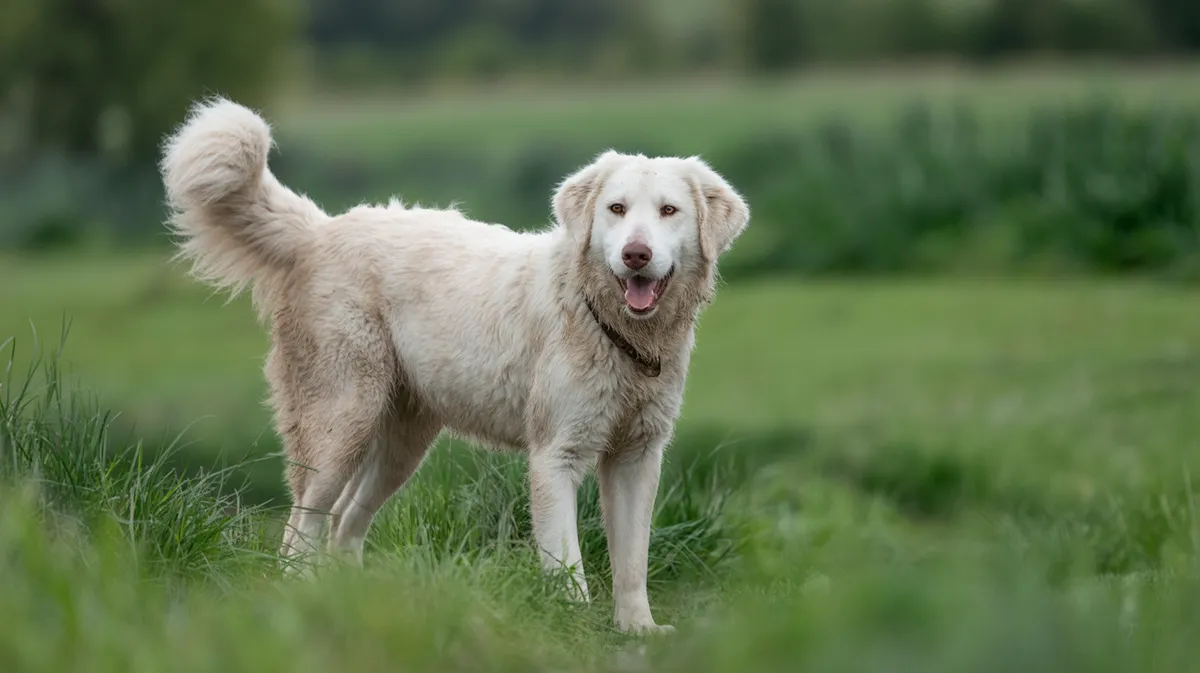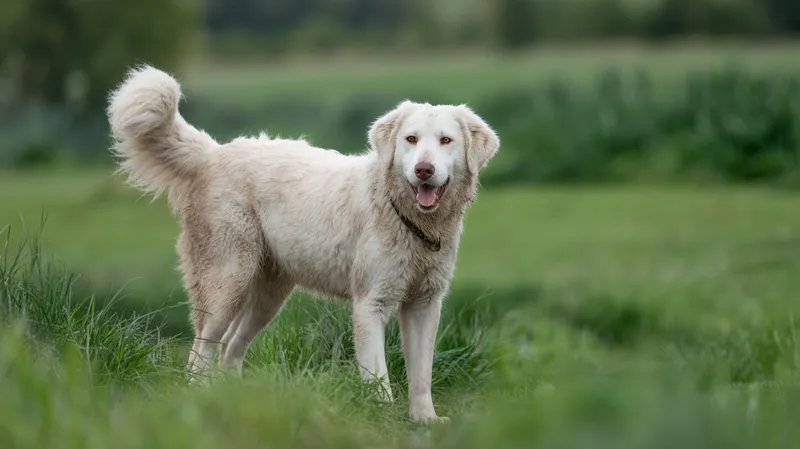
Kuvasz
Canis lupus familiaris

Meet the Kuvasz
The Kuvasz is a large, majestic breed of livestock guardian dog that originated in Hungary. Known for its striking white double coat and strong, muscular build, the Kuvasz was historically tasked with protecting flocks of sheep and property from predators. This breed is highly intelligent, independent, and loyal, with a strong protective instinct toward its family. Kuvasz dogs require early socialization and consistent training due to their natural wariness of strangers and independence.
Classification
Mammal
Habitat
Grasslands and rural agricultural areas
Diet
Omnivore
Lifespan
10-12 years
Conservation
Least Concern
Weight
32-52 kg (70-115 lbs)
📖Fascinating Facts
Ancient Heritage
The Kuvasz breed has roots tracing back to at least the 15th century and was favored by Hungarian nobility and royalty.
Royal Companions
King Matthias Corvinus of Hungary was known to have kept Kuvasz dogs both as personal protectors and for guarding his livestock.
Self-Reliant Guardians
Kuvasz are bred for independent thinking, enabling them to assess threats and take action without direct human command.
📋Detailed Description
The Kuvasz is a large, powerfully built livestock guardian dog, typically standing 66–76 cm (26–30 in) at the shoulder and weighing between 32–52 kg (70–115 lbs), with males generally larger than females. Its dense, double-layered white coat is both water-resistant and insulating, enabling the breed to withstand harsh weather conditions typical of the Hungarian plains. The head is elongated with a slightly domed skull, almond-shaped dark brown eyes, and well-set, V-shaped ears. Kuvaszok (plural) possess strong jaws and a scissor bite, suited for both defense and herding tasks. Their gait is fluid and effortless, reflecting their stamina and agility, which are essential for patrolling large territories. Behaviorally, the Kuvasz is highly intelligent, independent, and known for its acute senses, especially hearing and smell, which aid in early predator detection. Socially, they form strong bonds with their human families and livestock, exhibiting pronounced protective instincts and a natural wariness toward strangers. Reproduction in the Kuvasz is typical of large breeds, with moderate litter sizes and attentive maternal care. Unique adaptations include their ability to make autonomous decisions in the field, a trait selected for centuries to enable them to guard flocks without direct human supervision.
💡 Did you know?
The Kuvasz is one of the oldest known dog breeds, with records of the breed dating back to the Middle Ages.
🔬Research & Sources
Wikipedia Summary
The Kuvasz is a Hungarian breed of flock guardian dog. Mention of the breed can be found in old Hungarian texts. They have historically been royal guard dogs, or guarded livestock, but have been increasingly found in homes as pets over the last seventy years. The American Kennel Club includes the breed in the working dog group.
Last Modified: 1/17/2025
🎭Behavior & Social Structure
Kuvaszok display vigilant, territorial behavior, often patrolling perimeters and remaining alert to unfamiliar stimuli. They are not aggressive without cause but will respond assertively to perceived threats. Unlike herding breeds, Kuvaszok do not drive livestock but instead integrate themselves into the flock, acting as both deterrent and defender. Feeding behavior is typical of domestic dogs, though historically, they were fed a high-protein diet to support their active lifestyle. Social interactions within the breed are hierarchical, with clear dominance structures, but they are generally tolerant of other dogs and animals raised alongside them. Daily routines include periods of rest interspersed with active patrols, especially at dawn and dusk when predators are most active. Kuvaszok require significant mental and physical stimulation to prevent boredom-related behaviors such as digging or excessive barking.
👶Reproduction & Life Cycle
Kuvasz reach sexual maturity between 18–24 months. Mating typically occurs once a year, with the most common breeding season in late winter to early spring, aligning with traditional livestock birthing periods. The gestation period averages 58–65 days, resulting in litters of 6–10 puppies. Females exhibit strong maternal instincts, providing attentive care and protection to their offspring. Puppies are born blind and deaf, opening their eyes at around 10–14 days. Weaning occurs at 6–8 weeks, after which puppies begin socialization with livestock and humans. Responsible breeders emphasize early exposure to varied environments to foster stable temperaments.
🛡️Adaptations & Survival
The Kuvasz's thick, white double coat provides camouflage among sheep and protection from both cold and heat, as the outer coat reflects sunlight while the undercoat insulates. Their large size and muscular build serve as a physical deterrent to predators such as wolves and bears. Behavioral adaptations include independent problem-solving and decision-making, essential for effective flock guardianship in remote areas. Their acute senses, particularly hearing and olfaction, allow for early detection of threats. The breed's loyalty and protective instincts have been reinforced through centuries of selective breeding for livestock guardianship.
🎨Cultural Significance
The Kuvasz holds a prominent place in Hungarian history and folklore, often symbolizing loyalty, bravery, and nobility. Historically, they served as royal guard dogs, with records of their presence in the courts of Hungarian kings and nobility dating back to the 15th century. The breed is featured in Hungarian literature and art, and its name is believed to derive from the Turkish word 'kawasz,' meaning armed guard of the nobility. Today, the Kuvasz is celebrated as a national treasure in Hungary and is recognized internationally for its working abilities and companionship.
🔬Recent Research & Discoveries
Recent genetic studies have explored the Kuvasz's relationship to other Central Asian livestock guardian breeds, revealing both ancient origins and unique genetic markers associated with flock protection behavior. Ongoing research investigates the breed's cognitive abilities, particularly its capacity for independent decision-making and problem-solving in complex environments. Veterinary research has focused on breed-specific health concerns, including the prevalence of musculoskeletal disorders and immune-mediated diseases, with efforts to develop screening protocols for breeders. Ethological studies continue to examine the Kuvasz's socialization patterns and adaptability to modern lifestyles.
🎥Wildlife Videos

The Baltic | Survival in a Pristine Ecosystem | Animal documentary
Welcome to "The Baltic | Survival in a Pristine Ecosystem", a captivating wildlife documentary that transports you to the serene yet ...
WILD NATURE - Nature animal documentary

Wildlife - The Fascinating World of Wild Animals | Full Series | Free Documentary Nature
Wildlife - The Fascinating World of Wild Animals | Wildlife Documentary Watch 'Ocean Stories - Full Series' here: ...
Free Documentary - Nature

With David Attenborough: Nature’s Ingenious Ways to Survive (4K Documentary)
Join David Attenborough in this video as he uncovers the extraordinary ways life has adapted to survive in the most extreme ...
Our World

WILD SIBERIA | Survival Secrets of the Frozen Wilderness | Animal documentary
Welcome to "WILD SIBERIA | Survival Secrets of the Frozen Wilderness" – where we'll explore the extraordinary survival journey ...
WILD NATURE - Nature animal documentary

Awe-Inspiring Nature Scenes in 4K UHD | BBC Earth
Enjoy the best 4K wildlife footage that BBC Earth has to offer, narrated by Sir David Attenborough, David Tennant and more!
BBC Earth

THE SWISS ALPS | Secrets of the Apex Hunters | Animal documentary
Welcome to the majestic Swiss Alps, a breathtaking wilderness that's home to some of the most extraordinary apex predators on ...
WILD NATURE - Nature animal documentary
🌍Habitat Information
The Kuvasz typically inhabits Grasslands and rural agricultural areas environments. Kuvaszs have adapted to their environments with specialized features and behaviors.
Primary Habitat:
Grasslands and rural agricultural areas
More detailed habitat information will be available soon.
🛡️Conservation Status
The Kuvasz is currently classified as Least Concern. Conservation efforts are crucial for preserving this species for future generations.
Common Threats:
- 🏠Habitat loss and fragmentation
- 🌡️Climate change impacts
- 🎯Hunting and poaching
- 🏭Human-wildlife conflict
⚠️Threats & Conservation Challenges
While the Kuvasz is not currently at risk of extinction and is classified as 'Least Concern,' the breed faces challenges such as reduced demand for traditional livestock guardians due to changes in agricultural practices and predator management. Genetic bottlenecks and inbreeding are concerns in some populations, leading to increased susceptibility to hereditary diseases such as hip dysplasia and autoimmune disorders. Urbanization and the breed's unsuitability for inexperienced owners can result in behavioral issues or abandonment. Conservation efforts focus on maintaining genetic diversity and promoting responsible breeding practices.
🔬Scientific Classification
Scientific Name
Canis lupus familiaris
Classification Hierarchy
🔍 About Taxonomic Classification
Taxonomic classification is a hierarchical system used by scientists to classify and organize living organisms based on shared characteristics and evolutionary relationships.
The system moves from broad categories (Kingdom) to increasingly specific ones, with each animal's scientific name typically consisting of its Genus and species.
📝Community Notes
Share your observations and insights about the Kuvasz with our community of wildlife enthusiasts.
Join Our Community
Sign in to share your observations and connect with fellow wildlife enthusiasts.
Sign In to ContributeNo community notes yet
Be the first to share your observations about the Kuvasz!
Explore Kuvasz
Select a tab above to learn more about this amazing animal.
📸Photo Gallery
No photos available for this animal yet.
🌟Discover More Wildlife
Continue your journey of discovery with more fascinating animals from our database
